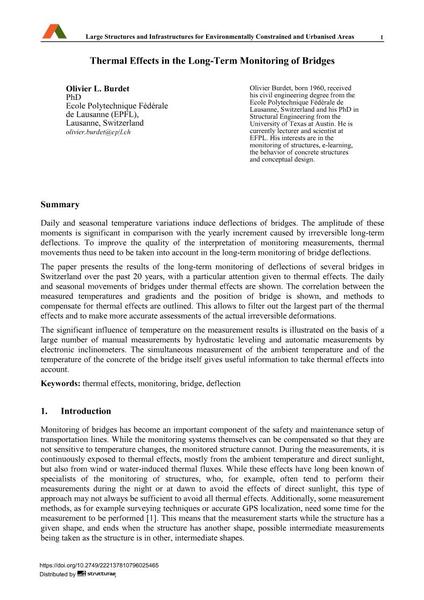Thermal Effects in the Long-Term Monitoring of Bridges

|
|
|||||||||||
Bibliographic Details
| Author(s): |
Olivier L. Burdet
|
||||
|---|---|---|---|---|---|
| Medium: | conference paper | ||||
| Language(s): | English | ||||
| Conference: | IABSE Symposium: Large Structures and Infrastructures for Environmentally Constrained and Urbanised Areas, Venice, Italy, 22-24 September 2010 | ||||
| Published in: | IABSE Symposium Venice 2010 | ||||
|
|||||
| Page(s): | 494-495 | ||||
| Total no. of pages: | 7 | ||||
| Year: | 2010 | ||||
| DOI: | 10.2749/222137810796025465 | ||||
| Abstract: |
Daily and seasonal temperature variations induce deflections of bridges. The amplitude of these moments is significant in comparison with the yearly increment caused by irreversible long-term deflections. To improve the quality of the interpretation of monitoring measurements, thermal movements thus need to be taken into account in the long-term monitoring of bridge deflections. The paper presents the results of the long-term monitoring of deflections of several bridges in Switzerland over the past 20 years, with a particular attention given to thermal effects. The daily and seasonal movements of bridges under thermal effects are shown. The correlation between the measured temperatures and gradients and the position of bridge is shown, and methods to compensate for thermal effects are outlined. This allows to filter out the largest part of the thermal effects and to make more accurate assessments of the actual irreversible deformations. The significant influence of temperature on the measurement results is illustrated on the basis of a large number of manual measurements by hydrostatic leveling and automatic measurements by electronic inclinometers. The simultaneous measurement of the ambient temperature and of the temperature of the concrete of the bridge itself gives useful information to take thermal effects into account. |
||||
| Keywords: |
bridge deflection thermal effects monitoring
|
||||
